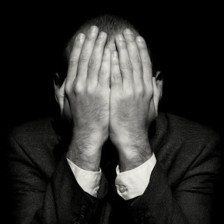“Positivity” – Use Gratitude, Mindfulness and Meditation to Overcome BDD
 According to the book Positivity, The ideal positivity ratio is 3:1
According to the book Positivity, The ideal positivity ratio is 3:1
Positive emotions are more subtle than negative ones and we, therefore, need more of them to balance out our emotion ratio.
The ideal ratio is 3:1 – three positive emotions for every negative one, and most of us can achieve this by practicing methods like mindfulness, meditation and writing a gratitude diary.
This ratio has been shown to help us acquire a positive attitude towards life, which makes us more resilient to negative emotions, more tolerant of others and more open to new experiences.
Actionable advice:
Keep a gratitude diary.
Research has shown that by just writing down five experiences that you are grateful for every day, you can easily increase your happiness. An experience you’re grateful for can be anything from a hot shower to an amazing party. When you write your experiences down, think about the emotions those experiences generated to create a deep emotional link.
Meditate for at least five minutes a day.
It can never be said enough: meditation is an amazing technique to increase our mindfulness and reduce stress, pain and anxiety. Try meditating for at least five minutes a day, either when you wake up or just before you go to bed – and if you keep up the habit, you can literally rewire your brain to make yourself feel more positive.
Be Mindful
Mindfulness lets you change your everyday feelingsMindfulness is the new buzzword we read about everywhere – with claims that if you cultivate
Mindfulness is the new buzzword we read about everywhere – with claims that if you cultivate it’s a powerful way to change your habits and intensify positive emotions in your everyday life.
But what exactly does mindfulness mean?
Mindfulness means consciously perceiving and enjoying every moment of your life by willfully focusing on the positive aspects of everything you experience. For instance, on your way to work, you can let your mind wander to your troubles, or you can focus on and savor the singing birds, the spring flowers or the children playing in the park. Or during a meal that you would usually mindlessly gulp down, you could focus on its many different tastes and textures.
But being mindful doesn’t only apply to positive emotions. It also means being aware of all the negative feelings you experience, so you can rationally examine and question them.
For example, I have just had this cancerous lesion removed from my nose. I can be grateful that we caught it early and it was removed without problems or I can stare at the deep scar and ruminate and hate on myself.ive
Being aware of the negative emotions and having the willful power to push them down and away is the key to obtaining mindfulness when you have BDD.
These reality checks help dissipate most negative emotions, especially our exaggerated reactions to unimportant things, like pimples, the way our nose looks, or various body image concerns that really don’t matter a whole lot in the scheme of things.
When you consider something like that calmly, it’s easy to laugh it off and refocus on the positive.
If this doesn’t work, there’s another way to break out of negative emotions:
Distract yourself.
Say a negative experience just won’t let you be, like some harsh words from a colleague about something you take very personally, maybe it is even something that triggers your BDD. For me, it would be my scars.
This is very hard but don’t keep thinking it over – instead, spend the time redirecting your attention into something useful, like reading through your unanswered emails.
Or sit down and write on your gratitude journal.
Another strategy is to re-evaluate the negative, and try to find something good about it: maybe your boss’ rude remarks or this cancerous scar is an interesting challenge for you to overcome? Maybe there is a lesson in this, maybe it is a reminder of just how precious and fleeting life can be.
Instead of feeling bad, what can you learn from this situation?
Gratitude, Mindfulness, and Meditation… These seem like a collection of very possible to accomplish actions steps, maybe it is time to get to work.




